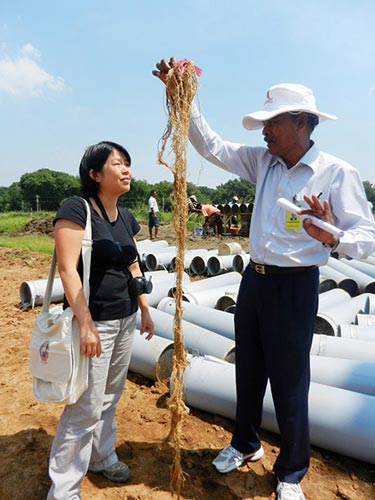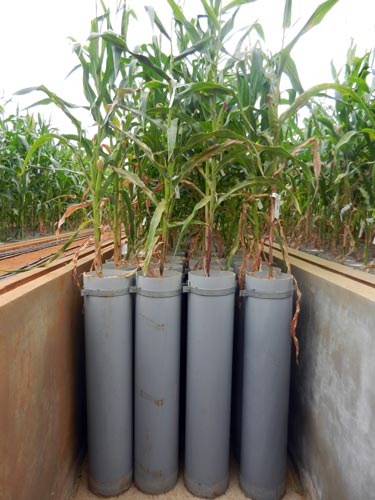By P.H. Zaidi/CIMMYT
A new facility at CIMMYT-Hyderabad, India, will allow researchers to assess and quantify key root traits and their dynamics under various growing conditions. CIMMYT’s new root phenotyping facility is based on the lysimetric system, by which scientists can directly assess and quantify root traits and their dynamics under various growing conditions. It also allows high-precision phenotyping of various root traits.

The system revolutionizes the research, moving from a static assessment of roots through time-consuming extraction and scanning to a real-time measurement of water uptake, water use and an assessment of variation in roots under different growing conditions in the rhizosphere. Recent advances in high-precision weighing systems and information technology tools have greatly improved its efficiency and effectiveness as a root phenotyping system.

CIMMYT’s root phenotyping facility is specially designed for – but not restricted to – maize. The facility features 2,400 minirhizotron observation tubes placed in eight concrete pits. A wheeled stand is used to lift the rhizotrons for weighing. The weight of the cylinder, along with the entire plant, is monitored periodically and allows researchers to estimate the amount of water used and transpired as well as the transpiration efficiency of different genotypes. Roots are critically important to plants because they are the part first exposed to any soil-mediated stresses, such as drought, waterlogging, salt stress or nutrient stress. Root traits govern the overall performance of plants; however, this important hidden half is often avoided due to the complexity involved in studying root structure and functions.

root phenotyping facility. Photo: T. Durga/CIMMYT
In maize, the genotypic variation in root traits and variation under stresses can be carefully selected in targeted breeding for stress tolerance, which can contribute significantly to genetic gains. Root traits are often judged on the basis of related characteristics, which may not accurately explain the stress-responsive — or adaptive — structural and functional changes in roots under sub-optimal or stressed conditions. The facility is used in phenotyping root traits of mapping populations developed for various molecular breeding projects on drought and heat stress tolerance as well as other traits usually observed in field conditions, including morphological traits and grain yield. It is located under a renovated rain shelter, protecting the trials from rain at the targeted crop stage and allowing for yearround use.
CIMMYT is grateful to the Syngenta Foundation for Sustainable Agriculture for its financial support of the facility and the International Crops Research Institute for the Semi- Arid Tropics for providing space and other logistic support in establishing this unique facility.
 Capacity development
Capacity development 
